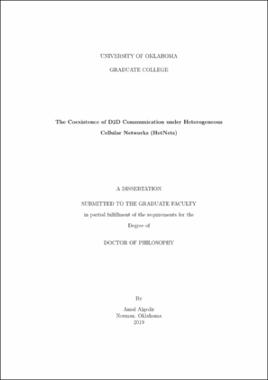| dc.contributor.advisor | Refai, Hazem | |
| dc.contributor.author | Algedir, Amal | |
| dc.date.accessioned | 2019-08-21T18:49:26Z | |
| dc.date.available | 2019-08-21T18:49:26Z | |
| dc.date.issued | 2019-07-25 | |
| dc.identifier.uri | https://hdl.handle.net/11244/321178 | |
| dc.description.abstract | Device-to-Device (D2D) communication is a promising technique for supporting the stringent requirements of the fifth-generation cellular network (5G). This new technique has garnered significant attention in cellular network standards for proximity
communication as a means to improve cellular spectrum utilization, to decrease user equipment energy consumption, and to reduce end-to-end delay.
This dissertation reports an investigation of D2D communication coexistence under 5G heterogeneous cellular network (HetNets) in terms of spectrum allocation and energy efficiency. The work reported herein describes a low-complexity D2D resource
allocation algorithm for downlink (DL) resource reuse that can be leveraged to improve network throughput. Notably, cross-tier interference was considered when establishing D2D communication (e.g., macro base station to D2D links; small base station to D2D links; and D2D communication to cellular links served by the macro and small base stations).
An allocation algorithm was introduced to reduce interference from D2D to cellular when a single D2D link is sharing cellular
resources. Performance of the proposed algorithm was evaluated and compared to various resource allocations. Simulation results demonstrated that the proposed algorithm improves overall system throughput. This allocation algorithm achieved
a near-optimal solution when compared with a brute force approach.
This dissertation also presents a novel framework for optimizing the energy efficiency of D2D communication coexistence with HetNets in DL transmission. This optimization problem was mathematically formulated in terms of mode selection, power control, and resources allocation (i.e., NP-hard problem). The optimization fraction problem was simplified based on network load and was solved using various optimization methods. An innovative dynamic mode selection based on Fuzzy clustering was also introduced. Proposed scheme performance was evaluated and compared to the standard algorithm. Simulation validated the advantage of the proposed framework in terms of performance gain in both energy efficiency and the number of successfully connected D2D users. Moreover, the energy efficiency of HetNets with D2D compatibility was improved.
Finally, this dissertation details a stochastic analytical model for an LTE scheduler with D2D communication. By assuming exponential distributions for users scheduling time, a throughput estimation model was developed using two-dimensional
Continuous Time Markov chains (2D-CTMC) of birth-death type. The proposed model will predict the expected number of D2D operated in dedicated and reuse mode, as well as the systems long-term throughput. | en_US |
| dc.language | en | en_US |
| dc.subject | Heterogeneous Cellular Network | en_US |
| dc.subject | Device-to-Device Communication | en_US |
| dc.subject | Energy Efficiency Optimization | en_US |
| dc.subject | Resource Allocation | en_US |
| dc.subject | Throughput Optimization | en_US |
| dc.subject | Continuous Time Markov chains model | en_US |
| dc.subject | Downlink power Control | en_US |
| dc.title | The Coexistence of D2D Communication under Heterogeneous Cellular Networks (HetNets) | en_US |
| dc.contributor.committeeMember | Runolfsson, Thordur | |
| dc.contributor.committeeMember | Imran, Ali | |
| dc.contributor.committeeMember | Kam Wai Clifford, Chan | |
| dc.contributor.committeeMember | Kisamore, Jennifer | |
| dc.date.manuscript | 2019-08-02 | |
| dc.thesis.degree | Ph.D. | en_US |
| ou.group | Gallogly College of Engineering::School of Electrical and Computer Engineering | en_US |
| shareok.orcid | 0000-0003-3396-540X | en_US |
| shareok.nativefileaccess | restricted | en_US |
